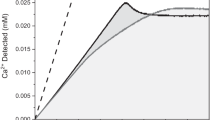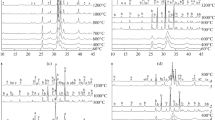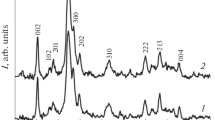Abstract.
The use of the metastable equilibrium solubility (MES) concept to describe the solubility properties of carbonated apatites (CAPs) and human dental enamel (HE) has been well established in previous studies using a range of CAPs with varying carbonate contents and crystallinities. It was shown in these studies that the mean value of the CAP MES is directly related to the broadening parameter full width at half maximum (FWHM) of the 002 reflection of the X-ray diffraction profile. The apparent solubility of the CAPs increased monotonically with an increase in the broadening of the diffraction peaks, and when this peak broadening was taken into account, carbonate had no additional effect upon the MES. The broadening of the diffraction peaks has been used as an indicator of crystallinity, and is generally influenced by both crystallite size and microstrain. The purpose of the present study was to extract the crystallite size and microstrain parameters separately from the X-ray diffraction peaks and then to determine their relationships to the corresponding MES values. The samples studied were CAPs synthesized by precipitation from Ca(NO3)2 and NaH2PO4 solutions in carbonate containing media at temperatures of 95, 80, and 70°C, and powdered HE. The crystallite size and microstrain parameters were determined simultaneously with the refinement of the structural parameters with the Rietveld method of whole-pattern-fitting structure-refinement. A modified pseudo-Voigt function was used to model the observed peak profiles. The MES distributions for the CAPs and HE were determined by a previously described method. The results of this study showed that the CAPs possessed an MES distribution and therefore provided further support that MES distribution is a common phenomenon, regardless of the method of CAP synthesis. The crystallite size decreased and the microstrain increased with increasing carbonate content and decreasing temperature of synthesis of the CAPs. A plot of the mean of the MES distribution versus the microstrain parameter showed that the apparent solubility of the CAPs and HE correlated very well with the microstrain parameter. On the other hand, a plot of the mean of the MES distribution versus the crystallite size parameter showed a poor correlation between MES and crystallite size. These findings support a view that microstrain, rather than crystallite size, is the dominant factor governing the effective solubility of the CAPs and dental enamel.
Similar content being viewed by others
Author information
Authors and Affiliations
Additional information
Received: 24 March 1998 / Accepted: 1 October 1998
Rights and permissions
About this article
Cite this article
Baig, A., Fox, J., Young, R. et al. Relationships Among Carbonated Apatite Solubility, Crystallite Size, and Microstrain Parameters. Calcif Tissue Int 64, 437–449 (1999). https://doi.org/10.1007/PL00005826
Issue Date:
DOI: https://doi.org/10.1007/PL00005826




